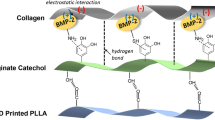Abstract.
Xenograft is considered an alternative material for bone transplantation, but its bone healing capacity is inferior compared to that of autografts and allografts. Here, we tested whether bone morphogenetic protein (BMP) addition enhances the suitability of demineralized xenogeneic bovine bone for bone grafting in dogs, and whether xenogeneic bone is a suitable carrier material for BMPs. The capacity of demineralized bovine bone implants, with and without native partially purified bovine BMP, to heal a 2-cm ulnar defect was determined in six dogs over a follow-up time of 20 weeks. No instances of bone union were seen, but there was slightly more bone formation in the xenografts with BMP, though the difference was not statistically significant. The ulnas treated with an implant with BMP were also mechanically stronger, but the difference was not significant. Computed tomography scans showed no differences in the implant area in bone density, bone mineral content, or bone cross-sectional area. It is concluded that native, partially purified BMP does not sufficiently improve the suitability of bovine demineralized xenografts as a bone substitute material for dog. Demineralized xenogeneic bone does not seem to be a feasible carrier material for BMP.
Résumé.
Les xénogreffes sont considérées comme des matériaux alternatifs aux transplants osseux, mais leur pouvoir réparateur pour l'os est inférieur à celui des autogreffes et des allogreffes. Nous avons cherché à déterminer si l'ajout de la protéine de morphogenèse osseuse (PMO) améliore la performance de l'os bovin xénogénique déminéralisé en tant que greffes osseuses chez le chien, et si l'os xénogénique constitue un véhicule efficace pour la PMO. Nous avons déterminé le pouvoir réparateur des implants osseux bovins déminéralisés, avec ou sans supplément de PMO native bovine partiellement purifiée, dans la guérison d'une résection ulnaire de 2 cm chez six chiens, sur une période de suivie post-opératoire de 20 semaines. L'union osseuse n'a été observée en aucun cas. Cependant, une formation osseuse plus abondante était observée dans les xénogreffes avec un supplément de PMO, mais la différence n'était pas statistiquement significative. Les os ulnaires traités avec une greffe à la PMO étaient aussi mécaniquement plus résistants, mais la différence n'était pas statistiquement significative. L'analyse tomographique n'a révélé aucune différence de densité osseuse, ni de composition minérale, ni de surface de section osseuse, dans la région de l'implant. Nous concluons que la PMO native partiellement purifiée n'améliore pas suffisamment l'aptitude des xénogreffes bovines déminéralisées à constituer un matériel de remplacement osseux chez le chien. L'os déminéralisé xénogénique ne semble pas être un véhicule efficace pour la PMO.
Similar content being viewed by others
Author information
Authors and Affiliations
Additional information
Electronic Publication
Rights and permissions
About this article
Cite this article
Tuominen, T., Jämsä, T., Tuukkanen, J. et al. Bovine bone implant with bovine bone morphogenetic protein in healing a canine ulnar defect. International Orthopaedics (SICOT) 25, 5–8 (2001). https://doi.org/10.1007/s002640000208
Accepted:
Published:
Issue Date:
DOI: https://doi.org/10.1007/s002640000208




